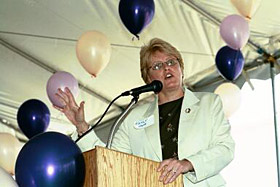 |
 |
 |
 Health & Beauty | August 2005 Health & Beauty | August 2005  
Quarter of Prop. 36 Drug Offenders Complete Treatment, UCLA Finds
 Don Thompson - Associated Press Don Thompson - Associated Press


| | Kathryn Jett, Director, State of California Department of Alcohol and Drug Program. |
Sacramento – Nearly five years ago, California voters approved a ballot measure that gave judges the discretion to send some nonviolent drug offenders to a drug treatment program instead of prison. About a quarter of those who entered the alternative treatment completed the program and had similar outcomes to traditional treatment methods, according to a new UCLA study.

The results, compiled each year, come at a time when legislators are debating whether to continue funding the alternative program and whether to amend the law to let judges jail offenders who refuse treatment or who keep abusing drugs.

Proposition 36, approved by 61 percent of voters in November 2000, requires that first-and second-time nonviolent drug offenders be sent to treatment programs instead of prison.

Its supporters say that SB 803, a Senate-approved bill that would amend Proposition 36, would unconstitutionally undermine voters' intentions by reinstating the possibility of jail time. The bill is currently awaiting Assembly consideration, and its detractors predicted a lengthy legal battle if the bill becomes law, as they expect.

The study released Monday by UCLA's Integrated Substance Abuse Programs sparked a renewed debate over how Proposition 36's results compare to alternative programs.

About 70 percent of those eligible under Proposition 36 entered treatment, and about 34 percent of the treated population completed the program, researchers found. Those figures, and the 25 percent completion rate for all those eligible under Proposition 36, are similar for other criminal justice referrals, said lead researcher Douglas Longshore, a behavioral scientist.

The Drug Policy Alliance and Campaign for New Drug Policies hailed that finding, while the California Narcotic Officers' Association said the results compare poorly to drug courts where judges are free to incarcerate those who don't attend treatment programs or who test positive for drug use.

"We think we can do better than 34 percent," said Kathryn Jett, director of California's Department of Alcohol and Drug Programs.

"For the 35,000 people who completed treatment, this program has been a lifesaver," Jett said, so the trick is getting more offenders through treatment. Though the department has not taken an official position on the pending Senate bill, Jett said methods to compel participation could include so-called "flash incarcerations."

Researchers found drug offenders under Proposition 36 were slightly more likely to have a new drug arrest in the first year than a similar group of offenders before the initiative passed. Longshore said the proportion is skewed because nearly a quarter of offenders under the old system were in prison and couldn't commit a new crime, though the narcotic officers' association said that shows the measure is dangerous.

Dr. Peter Banys, a past-president of the California Society of Addiction Medicine who opposes altering Proposition 36, said the initiative has been "relatively successful with an enormously complex population."

Before Proposition 36 passed, experts expected it would treat mainly young, relatively recent drug offenders. In fact, it has been an older group that often has been abusing drugs for years, many of whom had never been treated before.

In addition, the proposition's passage corresponded to "a methamphetamine epidemic spreading across the country," Banys said.

Nearly 53 percent of those entering treatment are addicted to meth, which can prompt severe mental health problems, violence and other treatment problems, researchers found. Yet they reported that drug programs have responded well and meth users completed treatment at roughly the same rates as other addicts.

Read the report at www.uclaisap.org/prop36/reports.htm
Read SB803 at www.sen.ca.gov | 
 | |
 |



